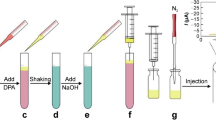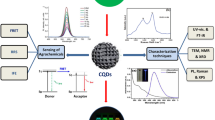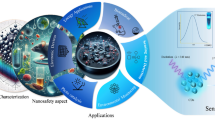Abstract
The authors describe a three-dimensional (3D) flexible interconnected porous nanocomposite membrane for use in surface-enhanced Raman scattering (SERS). It was obtained via in -situ deposition of gold nanoparticles (AuNPs, ca. 10 nm) on eggshell membranes (ESM). The AuNP/ESM nanocomposites were used as a SERS substrate for detection of the pesticide thiabendazole (TBZ) with prominent Raman bands at 1180, 1280, and 1580 cm−1. The abundant “hot spots” are generated by the closely arranged AuNPs in the 3D geometry of the ESM networks. This makes the SERS substrate highly sensitive because of remarkable signal amplification. The substrates were applied to the rapid detection of TBZ in Oolong tea. The limit of detection for TBZ is 0.1 ppm.

Schematic presentation of a three-dimensional flexible interconnected porous nanocomposite membrane as surface-enhanced Raman scattering (SERS) substrate for detection of thiabendazole (TBZ) in tea.








Similar content being viewed by others
References
Yuan Y, Panwar N, Yap SHK, Wu Q, Zeng S, Xu J, Tjin SC, Song J, Qu J, Yong K-T (2017) SERS-based ultrasensitive sensing platform: an insight into design and practical applications. Coordin Chem Rev 337:1–33
Szlag VM, Rodriguez RS, He J, Hudson-Smith N, Kang H, Le N, Reineke TM, Haynes CL (2018) Molecular affinity agents for intrinsic surface-enhanced Raman scattering (SERS) sensors. ACS Appl Mater Inter 10:31825–31844
He X, Yang D-P, Zhang X, Liu M, Kang Z, Lin C, Jia N, Luque R (2019) Waste eggshell membrane-templated CuO-ZnO nanocomposites with enhanced adsorption, catalysis and antibacterial properties for water purification. Chem Eng J 369:621–633
Alula MT, Krishnan S, Hendricks NR, Karamchand L, Blackburn JM (2017) Identification and quantitation of pathogenic bacteria via in-situ formation of silver nanoparticles on cell walls, and their detection via SERS. Microchim Acta 184:219–227
Chen Y, Zhang Y, Pan F, Liu J, Wang K, Zhang C, Cheng S, Lu L, Zhang W, Zhang Z, Zhi X, Zhang Q, Alfranca G, de la Fuente JM, Chen D, Cui D (2016) Breath analysis based on surface-enhanced Raman scattering sensors distinguishes early and advanced gastric Cancer patients from healthy persons. ACS Nano 10:8169–8179
Tian F, Conde J, Bao C, Chen Y, Curtin J, Cui D (2016) Gold nanostars for efficient in vitro and in vivo real-time SERS detection and drug delivery via plasmonic-tunable Raman/FTIR imaging. Biomaterials 106:87–97
Chen Y, Cheng S, Zhang A, Song J, Chang J, Wang K, Zhang Y, Li S, Liu H, Alfranca G, Aslam MA, Chu B, Wang C, Pan F, Ma L, de la Fuente JM, Ni J, Cui D (2018) Salivary analysis based on surface enhanced Raman scattering sensors distinguishes early and advanced gastric Cancer patients from healthy persons. J Biomed Nanotechnol 14:1773–1784
Wang L, Guo T, Lu Q, Yan X, Zhong D, Zhang Z, Ni Y, Han Y, Cui D, Li X, Huang L (2015) Sea-urchin-like au nanocluster with surface-enhanced raman scattering in detecting epidermal growth factor receptor (EGFR) mutation status of malignant pleural effusion. ACS Appl Mater Interfaces 7:359–369
Wang Y, Jin Y, Xiao X, Zhang T, Yang H, Zhao Y, Wang J, Jiang K, Fan S, Li Q (2018) Flexible, transparent and highly sensitive SERS substrates with cross-nanoporous structures for fast on-site detection. Nanoscale 10:15195–15204
Liu M, Zheng C, Cui M, Zhang X, Yang DP, Wang X, Cui D (2018) Graphene oxide wrapped with gold nanorods as a tag in a SERS based immunoassay for the hepatitis B surface antigen. Mikrochim Acta 185:458
Fu G, Sun DW, Pu H, Wei Q (2019) Fabrication of gold nanorods for SERS detection of thiabendazole in apple. Talanta 195:841–849
Kim NH, Hwang W, Baek K, Rohman MR, Kim J, Kim HW, Mun J, Lee SY, Yun G, Murray J, Ha JW, Rho J, Moskovits M, Kim K (2018) Smart SERS hot spots: single molecules can be positioned in a Plasmonic Nanojunction using host-guest chemistry. J Am Chem Soc 140:4705–4711
Wang R, Xu Y, Wang R, Wang C, Zhao H, Zheng X, Liao X, Cheng L (2017) A microfluidic chip based on an ITO support modified with ag-au nanocomposites for SERS based determination of melamine. Microchim Acta 184:279–287
Xu Q, Guo X, Xu L, Ying Y, Wu Y, Wen Y, Yang H (2017) Template-free synthesis of SERS-active gold nanopopcorn for rapid detection of chlorpyrifos residues. Sensors Actuators B Chem 241:1008–1013
Wang Y, Su Z, Wang L, Dong J, Xue J, Yu J, Wang Y, Hua X, Wang M, Zhang C, Liu F (2017) SERS assay for copper(II) ions based on dual hot-spot model coupling with MarR protein: new cu(2+)-specific biorecognition element. Anal Chem 89:6392–6398
Kearns H, Goodacre R, Jamieson LE, Graham D, Faulds K (2017) SERS detection of multiple antimicrobial-resistant pathogens using nanosensors. Anal Chem 89:12666–12673
Chappa S, Mhatre AM, Adya VC, Pandey AK (2017) Egg-shell membrane mimicking synthetic polymer membrane supported palladium nanoparticles for catalyzing reduction of uranyl(VI) ions. Appl Catal B-Environ 203:53–64
Yin L, Xu G, Nie P, Dou H, Zhang X (2018) MXene debris modified eggshell membrane as separator for high-performance lithium-sulfur batteries. Chem Eng J 352:695–703
Zhong SL, Zhuang J, Yang DP, Tang D (2017) Eggshell membrane-templated synthesis of 3D hierarchical porous au networks for electrochemical nonenzymatic glucose sensor. Biosens Bioelectron 96:26–32
Celina Selvakumari J, Nishanthi ST, Dhanalakshmi J, Ahila M, Pathinettam Padiyan D (2018) Bio-active synthesis of tin oxide nanoparticles using eggshell membrane for energy storage application. Appl Surf Sci 441:530–537
Huang J, Lin L, Sun D, Chen H, Yang D, Li Q (2015) Bio-inspired synthesis of metal nanomaterials and applications. Chem Soc Rev 44:6330–6374
Yang P, Xie J, Zhong C (2018) Biowaste-derived three-dimensional porous network carbon and bioseparator for high-performance asymmetric supercapacitor. ACS Appl Energy Mater 1:616–622
Preetam Guha Ray PP, Kumar Srivas P, Basak P, Roy S Dhara a S(2018) Surface modification of eggshell membrane with electrospun chitosan Polycaprolactone nanofibers for enhanced dermal wound healing. ACS Appl Bio Mater 1:985–998
Manthiram S-HC a A (2014) Eggshell membrane-derived polysulfide absorbents for highly stable and reversible lithium–sulfur cells. ACS sustain. Chem. 2:2248–2252
Yang D-P, Chen S, Huang P, Wang X, Jiang W, Pandoli O, Cui D (2010) Bacteria-template synthesized silver microspheres with hollow and porous structures as excellent SERS substrate. Green Chem 12:2038
Chung SH, Manthiram A (2014) Carbonized eggshell membrane as a natural polysulfide reservoir for highly reversible Li-S batteries. Adv Mater 26:1360–1365
Alsammarraie FK, Lin M, Mustapha A, Lin H, Chen X, Chen Y, Wang H, Huang M (2018) Rapid determination of thiabendazole in juice by SERS coupled with novel gold nanosubstrates. Food Chem 259:219–225
Kaur M, Raj P, Singh N, Kuwar A, Kaur N (2018) Benzimidazole-based imine-linked copper complexes in food safety: selective detection of Cyproheptadine and Thiabendazole. ACS Sustain Chem Eng 6:3723–3732
Kumar S, Goel P, Singh J (2017) Flexible and robust SERS active substrates for conformal rapid detection of pesticide residues from fruits. Sensor Actuat B-Chem 241:577–583
Dong Y, Yang L, Zhang L (2017) Simultaneous electrochemical detection of Benzimidazole fungicides Carbendazim and Thiabendazole using a novel Nanohybrid material-modified electrode. J Agric Food Chem 65:727–736
Liou P, Nayigiziki FX, Kong F, Mustapha A, Lin M (2017) Cellulose nanofibers coated with silver nanoparticles as a SERS platform for detection of pesticides in apples. Carbohydr Polym 157:643–650
Chang W, Liu S, Qileng A, Liu W, Liu Y (2018) In-situ synthesis of monodispersed au nanoparticles on eggshell membrane by the extract of Lagerstroemia speciosa leaves for the catalytic reduction of 4-nitrophenol. Mater Res Express 6
Liu B, Zhou P, Liu X, Sun X, Li H, Lin M (2012) Detection of pesticides in fruits by surface-enhanced Raman spectroscopy coupled with gold nanostructures. Food Bioprocess Tech 6:710–718
Acknowledgements
This study was supported by the National Natural Science Foundation of China (Grant No. 81472001), the Tongjiang Scholars Program of Quanzhou City, Natural Science Foundation of Fujian Province (2015 J05030), and Quanzhou City Science & Technology Program of China (2017G023).
Author information
Authors and Affiliations
Corresponding authors
Ethics declarations
The author(s) declare that they have no competing interests.
Additional information
Publisher’s note
Springer Nature remains neutral with regard to jurisdictional claims in published maps and institutional affiliations.
Electronic supplementary material
ESM 1
(DOCX 104 kb)
Rights and permissions
About this article
Cite this article
Ding, Q., Kang, Z., He, X. et al. Eggshell membrane-templated gold nanoparticles as a flexible SERS substrate for detection of thiabendazole. Microchim Acta 186, 453 (2019). https://doi.org/10.1007/s00604-019-3543-1
Received:
Accepted:
Published:
DOI: https://doi.org/10.1007/s00604-019-3543-1




